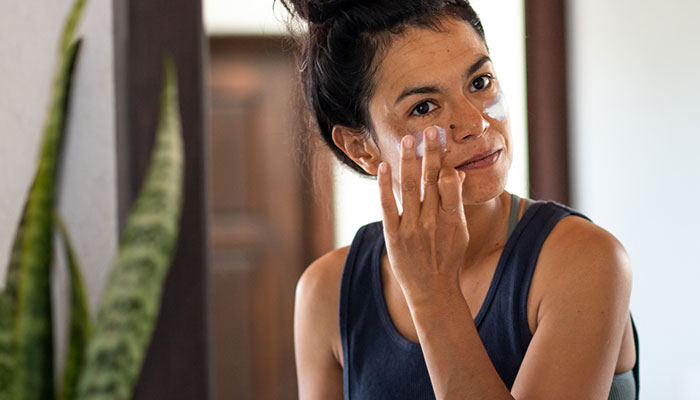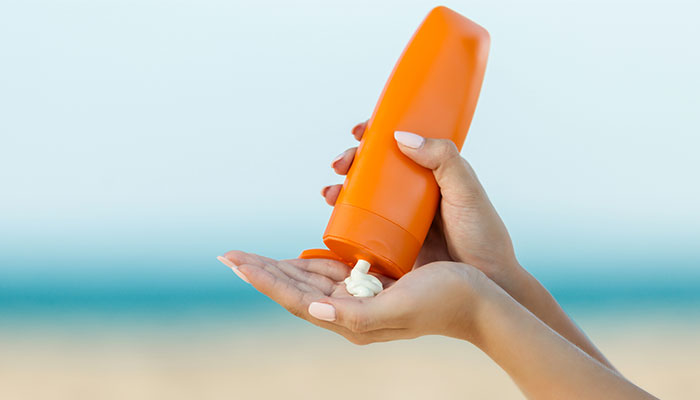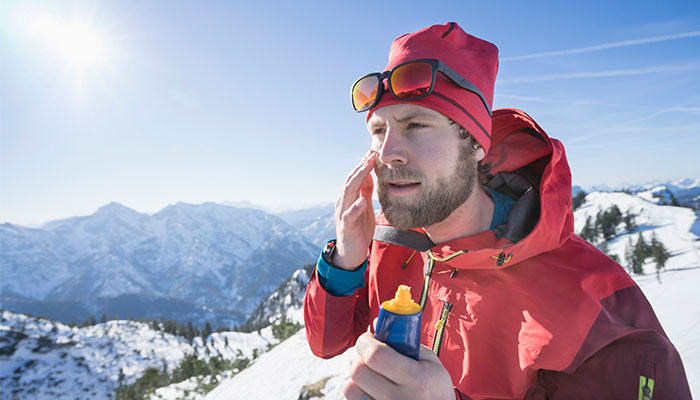We were first told to “slip, slop, slap” more than 40 years ago, but do we really know how to use sunscreen properly?

Despite ongoing public health campaigns and the availability of hundreds of sun protection products, Australia still has one of the highest rates of skin cancer in the world.
More than 2000 Australians die from skin cancer every year, and by the age of 70, two thirds of us will have been diagnosed with some type of skin cancer.
Sunscreen protects us by preventing ultraviolet (UV) rays from damaging our skin. That includes both UVA, which makes up most of the sun’s energy, and the more harmful UVB rays. UVA is often associated with ageing, but both types of UV rays are linked to the development of skin cancers.
Sunscreen 101
There are two types of sunscreen: mineral and chemical. Zinc cream is a mineral sunscreen that forms a physical barrier between your skin and the sun. To work properly, it needs to be thickly applied – think cricketers’ noses and lips.
Chemical sunscreens use ingredients like avobenzone and oxybenzone that convert UV rays to heat. They are designed to be absorbed into the skin, but you still need at least a teaspoon (4.5ml) to cover your face, neck and ears, another teaspoon for each limb and so on. We have all missed patches when applying sunscreen, so be thorough and make sure it covers all your exposed skin.
No matter what sunscreen you use, you can’t expect to put it on in the morning, and for it to be still effective in the afternoon.
All sunscreens on sale in Australia have been assessed and approved by the Therapeutic Goods Administration (TGA) and are safe to use for all age groups, including children.
The best sunscreen to choose is the one you are most comfortable with and therefore the most likely to use daily.
No matter what sunscreen you use, you can’t expect to put it on in the morning, and for it to still be effective in the afternoon. A good rule of thumb is to apply it 20 minutes before going into the sun, then every two to three hours after that, but more often if you are sweating or getting in and out of the water.
Skin tone matters
In the past, it was thought that everyone should wear sunscreen, regardless of their skin tone and genetic risk. The recent position statement from Australian Skin and Skin Cancer Research Centre (ASSC) suggests that we need to consider an individual’s genetic risk of skin cancer.

People with darker skin tones have more difficulty absorbing benefits from the sun, meaning they need more UVB to produce vitamin D. It is relatively easy to replace vitamin D with a supplement but there are other benefits from the sun for the immune and nervous system that cannot be disregarded.
The latest advice is that people with darker skin types do not need to routinely wear sun protection unless they are exposed to the sun for an extended period.
People with pale skin remain at the highest risk of developing skin cancer and are advised to be very cautious with sun exposure.
The expiry date is important
Sunscreens sold in Australia are regulated by the TGA and carry an expiry date. After that date, the ingredients in sunscreen may no longer be effective and cannot provide reliable protection from UV radiation. In general, sunscreens last for two to three years, but that can be reduced depending on how it has been stored.
To get the most out of your sunscreen, store it away from direct sunlight and in temperatures cooler than 30 degrees. Keeping sunscreen in the car may be convenient, but the heat will cause it to break down and separate. If your sunscreen is past its use-by date, or the consistency has changed to something lumpy, watery or gritty, it’s time to replace it.
Understanding SPF ratings
The higher a sunscreen’s sun protection factor (SPF), the fewer UV rays will reach your skin. Always use a broad‑spectrum sunscreen to protect from both UVA and UVB, and choose the highest SPF available.
Weather is not always a good indicator of UV levels. A cool or overcast day may not necessarily equal low UV. Because of this, it is important to apply sunscreen all year around, not just in summer.
If you would normally begin to burn after 10 minutes in the sun without any protection, then an SPF15 product will protect you for about 150 minutes and SPF30 for about 300 minutes. SPF50+ sunscreens prevent all but 2 per cent of UV rays from reaching your skin, while SPF30 will protect us from all but 3.3 per cent of UVB rays.
SPF50+ is the highest protection level available in Australia and there are no hacks to get more out of your products. Layering an SPF15 moisturiser or foundation with an SPF50+ sunscreen does not equal a sun protection factor of 65. You only get the same level of protection as the highest-rated product you have used, and the moisturiser may actually dilute the sunscreen.
Check the day’s UV rating
Weather is not always a good indicator of UV levels. Hot days often come with high UV danger, but a cool or overcast day may not necessarily equal low UV. Because of this, it is important to apply sunscreen all year around, not just in summer.
The best indicator is the day’s UV rating, which will range from 0 (low) to 11+ (extreme). For people with lighter skin types, the recommendation is to wear sunscreen if the UV index is 3 or above. To check daily UV ratings, visit the Bureau of Meteorology website or download the free Sunsmart Global UV app. Some weather apps also include this information.
Shade might not be enough
Being in the shade does offer some protection from UV rays, but you should still apply sunscreen just the same as if you were in full sun.
We might imagine that UV rays fall like rain, but they can easily be reflected from surfaces like glass, water, sand, and snow. If you can see the sky, you are still at risk of burning, and that includes when you are near a window or inside a car. Glass can protect from UVB rays, but unless it is specially coated, UVA rays will pass right through.

Some clothing offers protection from the sun, but not all. You can still burn through gauzy or very thin material, so aim for closely woven fabrics or those specifically designed for sun protection and apply sunscreen to any exposed skin. Top it off with a broad-brimmed hat and sunglasses.
What about vitamin D?
Vitamin D is necessary for healthy bones, but to produce enough from sun exposure alone, we would need to spend about 20 to 30 minutes in the sun each day. Vitamin D is produced by the more damaging UVB rays, and conversion is most effective when the sun is high in the sky, which is also the time when we’re most at risk of burning.
Some foods, like oily fish or fortified cereals, contain vitamin D but it is unlikely to be enough to meet our bodies’ needs.
In Australia, the safest and most effective way for people with lighter skin types to get sufficient vitamin D is through supplements.
When to get your skin checked
It is important to monitor all lesions and skin marks, even freckles and light-coloured moles. Warning signs to watch for include new lesions, and anything that is changing, hurting, bleeding or not healing. If you notice any of these things, get checked immediately.
In general, it is a good idea to get your first skin check from the ages 30-40. A check takes around 20 minutes, and your doctor will be able to set a baseline for future comparison and advise on how often you should be checked in future depending on your risk. A higher risk individual, for instance, those with personal or family history of melanoma or other skin cancer, on immunosuppressive therapy or have many moles on their skin can be checked earlier or more frequently.
The bottom line
There is no safe level of tan. Even if you go red but turn brown the next day, your skin has still been damaged. The only safe tan is a fake tan – from a bottle, not from sunbeds, which have been linked to melanoma.
Dr Vivianne Xie is a general practitioner at MQ Health’s Skin Cancer Clinic.
To book an appointment call +61 (2) 9812 3765.








